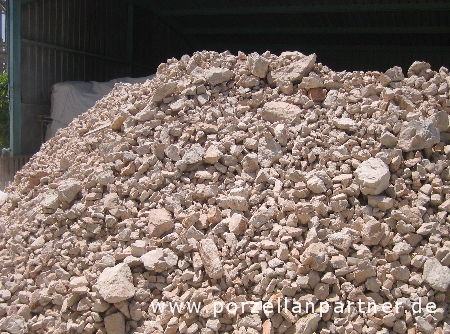Feldspar

The raw material feldspar gives its name to the highest quality classification of hard porcelain and therefore deserves both special attention and further explanation. Genuine hard porcelain is also known as "feldspar porcelain" and thus expresses the fact that the declaration of the raw material alone specifically indicates the quality, durability and hardness of the product to the porcelain maker. The term "feldspar porcelain" really means something to a specialist.
Feldspar is a collective term for a group of minerals that make up around 60% of the composition of the earth's crust.
Feldspar types
1st Potassium feldspar (orthoclase), KAlSi3O8, with varieties such as adular, sanidine; white to red, monoclinic, easily cleavable into 2 (perpendicular to each other) planes; weathers to kaolin.
2nd Soda-lime feldspar (plagioclase), whitish, triclinic, easily cleavable like 1); a solid solution of albite, NaAlSi3O8 (green-coloured variety: periclase) and anorthite, Ca[Al2Si2O8], in varying molar ratios; with polysynthetic twinning; weathers to calcium-, aluminium- and especially sodium-containing deposits.
3rd Microlin, similar to potassium feldspar but with a complicated twinned ("lattice structure"), triclinic, contains sodium as well as potassium. In addition to the known deposits of feldspar in Western Europe, high-quality feldspar can be found in China, England, Turkey and Egypt.
The raw material deposits make it clear why China, Germany, Poland, the Czech Republic and Turkey are among the leading porcelain nations.
Feldspar in porcelain production
Potassium feldspars are mainly used in porcelain production because their colour, hardness (Mohs 6 - 6.5) and sintering properties make them the most suitable.
During the hard firing in the porcelain kiln, the feldspar melts to form a "feldspar glass" and also releases further microscopically small quartz crystals. This viscous mass is then absorbed by the quartz added to the porcelain mass during the melting process and binds the undissolved crystalline substances (mullite) to form a homogeneous mass.
Due to its low melting point of 1,150 °C to 1,250 °C, feldspar serves as a kind of melting accelerator and adhesive for the solid crystals, which remain undissolved in the porcelain mass at approx. 1,350 °C. Ultimately, feldspar seals and binds the raw materials used in porcelain production and is responsible for sintering and sealing the body. Ultimately, the feldspar seals and binds the raw materials for porcelain production and is responsible for the sintering and sealing of the body.
You could also say that feldspar is the "glue" of the porcelain paste.
